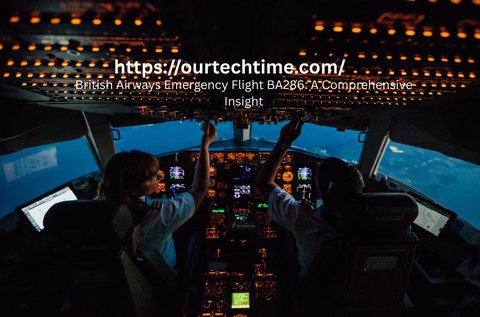Air travel is often perceived as one of the safest modes of transportation. Yet, when the term emergency flight surfaces, it instantly sparks attention. Among such instances, the phrase British Airways emergency flight BA286 has gained significance. Whether you are an aviation enthusiast, a frequent traveler, or simply curious about how airlines manage emergencies, this comprehensive article will guide you through every aspect of such a scenario. From the technical details of British Airways operations to passenger experiences, safety protocols, and the broader implications for the aviation industry, this piece provides a 360-degree analysis.
Background of British Airways Flight BA286
Route and Operation
Flight Number: BA286
Typical Route: San Francisco International Airport (SFO) to London Heathrow (LHR)
Aircraft Type: Often operated by Boeing 777 or Boeing 787 Dreamliner
Duration: Approximately 10–11 hours
This long-haul flight connects two major global hubs, carrying business professionals, tourists, and connecting passengers. Given the long distance and international significance, BA286 plays a vital role in the British Airways network.
Why BA286 Matters
The route bridges Silicon Valley’s innovation hub with London’s financial center. Any disruption, especially an emergency, has ripple effects—impacting not just passengers but also global business schedules.
What Constitutes an “Emergency Flight”?

General Aviation Definition
An emergency flight refers to any airborne situation where the aircraft deviates from its normal plan due to:
Technical issues
Passenger medical emergencies
Severe weather
Security threats
Fuel or operational concerns
Specific Context of BA286
When BA286 is labeled as an “emergency flight,” it often involves a diversion, return to departure airport, or priority landing request.
Common Causes of Emergency Situations on BA286
Technical Malfunctions
Engine irregularities
Hydraulic or electrical issues
Sensor or software glitches
Passenger Medical Emergencies
Heart attacks
Respiratory issues
Severe allergic reactions
Adverse Weather Conditions
Turbulence
Heavy storms en route
Low visibility at arrival
Operational or Crew Factors
Crew illness or fatigue
Fuel management challenges
Passenger Experience During Emergencies
Initial Signs
Passengers often first notice unusual announcements:
“Ladies and gentlemen, we have a minor technical issue…”
Sudden change in altitude or flight path visible on in-flight maps.
Emotional Reactions
Calm but Alert: Many seasoned travelers trust the crew.
Anxious and Restless: First-time flyers may panic.
Reassured: Cabin crew’s professionalism plays a critical role.
Comfort Measures
British Airways ensures:
Clear communication from pilots
Immediate medical assistance for health-related incidents
Priority landing at the nearest safe airport
British Airways Safety and Emergency Protocols
Pre-Flight Checks
Before every BA286 departure:
Engineers conduct system inspections
Pilots review weather forecasts
Crew undergoes safety briefings
In-Flight Emergency Response
Cabin Crew Training: British Airways requires rigorous yearly certifications.
Onboard Medical Kits: Defibrillators, oxygen tanks, and advanced first-aid supplies.
Collaboration with Ground Teams: Real-time communication with Heathrow operations center.
Diversion Strategy
If an emergency occurs:
Nearest suitable airport is identified.
Air Traffic Control grants priority clearance.
Emergency services prepare for landing.
The Role of the Pilots
Pilots on BA286 are highly trained for transatlantic routes.
Experience Level: Typically, senior captains with thousands of flying hours.
Decision-Making: Balancing safety, passenger comfort, and operational impact.
Simulation Training: Frequent drills for engine failures, medical emergencies, and severe turbulence.
Aircraft Used for BA286 and Their Safety Features
Boeing 777
Twin-engine reliability
Redundant hydraulic systems
Advanced weather radar
Boeing 787 Dreamliner
Composite body for fuel efficiency
Advanced avionics
Cabin pressure control for passenger health
Both aircraft models are designed with multiple backup systems, making emergencies rare but manageable.
Case Studies: Past Instances of BA286 Emergencies
Medical Diversions
Several BA286 flights have diverted mid-Atlantic when passengers suffered cardiac arrests.Technical Returns
On rare occasions, aircraft have returned to San Francisco due to engine alerts.Weather-Related Challenges
Strong Atlantic headwinds have occasionally caused extended flight times and fuel concerns.
Each case demonstrates British Airways’ strict adherence to safety over schedules.
Psychological Impact on Passengers
Immediate Stress
Elevated anxiety
Increased heart rate
Restlessness
Post-Flight Reflections
Many passengers report:
Renewed trust in aviation safety
Stories to share with family and colleagues
Gratitude toward crew professionalism
Impact on Airline Operations
Financial Implications
Diversions cost airlines tens of thousands of dollars.
Compensation and rescheduling add to expenses.
Scheduling Disruptions
Ripple effect on connecting flights.
Crew duty-hour limitations may delay subsequent flights.
Reputation Management
British Airways emphasizes transparency and communication to maintain passenger trust.
Media Coverage of BA286 Emergencies
Emergencies often make headlines.
Sensational reporting can exaggerate risks.
Aviation authorities usually clarify the actual severity afterward.
This highlights the importance of balanced information.
Lessons for Frequent Flyers
Always Stay Informed
Pay attention to crew briefings.
Familiarize yourself with exit locations.
Health Preparedness
Carry necessary medications in hand luggage.
Inform crew of any medical condition.
Psychological Readiness
Understand that emergencies are rare but manageable.
Trust the expertise of airline professionals.
British Airways’ Commitment to Passenger Safety
Investments
Fleet modernization
Enhanced training modules
Upgraded medical equipment
Passenger Assurance
Every incident strengthens procedures, making BA286 and other routes safer over time.
The Broader Aviation Perspective
Industry Standards
International Civil Aviation Organization (ICAO) sets global norms.
British Airways often exceeds baseline requirements.
Future of Safety
Artificial intelligence monitoring engines.
Advanced medical telemedicine onboard.
Real-time satellite tracking.
Myths vs. Facts About BA286 Emergencies
Myth: An emergency means a crash is imminent.
Fact: Most emergencies are precautionary and well-controlled.Myth: Long flights are more dangerous.
Fact: Long-haul aircraft are among the safest in the sky.Myth: Passengers are helpless.
Fact: Crew training ensures passenger guidance at every step.
Human Stories: Passengers and Crew Testimonials
Passengers often praise calm cabin crew.
Some recount strangers supporting each other during turbulence.
Crew members express pride in handling challenges effectively.
Such stories reflect the human side of aviation.
Future Outlook for BA286
British Airways is expected to introduce newer aircraft on the route.
Continued investment in safety technology will further minimize risks.
Passenger awareness campaigns may enhance trust.
Conclusion
The phrase British Airways emergency flight BA286 embodies both the challenges and strengths of modern aviation. While emergencies inevitably cause stress, the reality is that British Airways, like most major carriers, has robust systems to handle them effectively. From well-trained crews and technologically advanced aircraft to transparent communication and industry-leading safety standards, the airline ensures that passenger welfare remains the highest priority.
Flying on BA286 or any long-haul route may sometimes face turbulence—both literally and figuratively. Yet, the overwhelming evidence shows that passengers are in capable hands. Emergencies are rare, but when they do occur, they reinforce the strength, resilience, and professionalism of the aviation industry.
FAQs
1. What is British Airways flight BA286?
BA286 is the daily long-haul service from San Francisco International Airport to London Heathrow, operated by British Airways.
2. Why is it called an “emergency flight”?
The term is used when BA286 experiences a diversion, technical issue, or onboard emergency requiring special handling.
3. How safe is BA286?
BA286 is considered extremely safe, with world-class aircraft, highly trained pilots, and robust safety procedures.
4. What happens if BA286 diverts mid-Atlantic?
The aircraft usually lands at the nearest suitable airport, often in Canada, Iceland, or Ireland, depending on the situation.
5. How should passengers react during an emergency?
Remain calm, follow crew instructions, and trust that protocols are designed for maximum passenger safety.
